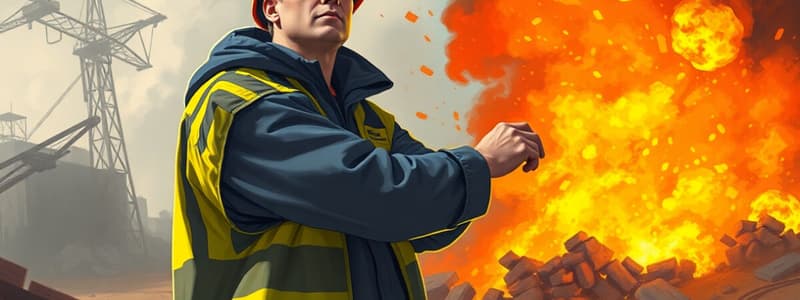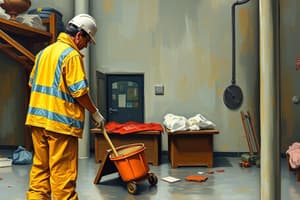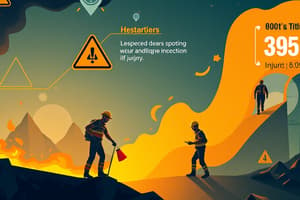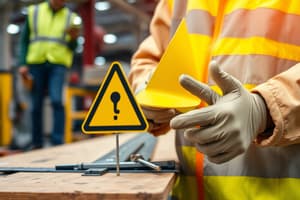Podcast
Questions and Answers
What is the primary difference between a near-miss and an accident resulting in property damage?
What is the primary difference between a near-miss and an accident resulting in property damage?
- A near-miss is always reported, while property damage incidents are often overlooked.
- A near-miss involves injuries, while property damage does not.
- A near-miss results in serious injuries, while property damage results in only minor injuries.
- A near-miss has no injuries or damage, while property damage involves damage to tools, materials, or equipment. (correct)
If a worker strains their back and is unable to return to full duty on their next scheduled shift, how is this incident classified?
If a worker strains their back and is unable to return to full duty on their next scheduled shift, how is this incident classified?
- Near-miss
- Minor injury
- Property damage
- Serious or disabling injury (correct)
Which of the following best describes the key purpose of reporting near-miss incidents?
Which of the following best describes the key purpose of reporting near-miss incidents?
- Documenting minor property damage for accounting purposes.
- Identifying and addressing potential hazards before they cause harm. (correct)
- Assigning blame for unsafe acts.
- Calculating potential insurance costs.
Which of the following is NOT one of the 'Focus Four' construction hazards?
Which of the following is NOT one of the 'Focus Four' construction hazards?
What distinguishes a 'serious or disabling injury' from a 'minor injury'?
What distinguishes a 'serious or disabling injury' from a 'minor injury'?
Which of the following is an example of an unsafe act leading to a safety incident?
Which of the following is an example of an unsafe act leading to a safety incident?
In what scenario would a trench most likely be the location of an accident?
In what scenario would a trench most likely be the location of an accident?
What is a key characteristic that differentiates property damage from a near-miss?
What is a key characteristic that differentiates property damage from a near-miss?
What is the primary responsibility of an employee regarding HAZCOM (Hazard Communication)?
What is the primary responsibility of an employee regarding HAZCOM (Hazard Communication)?
Which of the following incidents would be classified as a 'fatality'?
Which of the following incidents would be classified as a 'fatality'?
Which of the following is NOT a source of energy release?
Which of the following is NOT a source of energy release?
What is the flash point of a combustible material?
What is the flash point of a combustible material?
What is the primary characteristic of a confined space?
What is the primary characteristic of a confined space?
Which situation exemplifies a failure to communicate, potentially causing a safety incident?
Which situation exemplifies a failure to communicate, potentially causing a safety incident?
Which action would identify someone as a 'competent person' on a job site?
Which action would identify someone as a 'competent person' on a job site?
In the context of work site incidents, what does 'management failure' typically refer to?
In the context of work site incidents, what does 'management failure' typically refer to?
Which of the following is the MOST accurate definition of a safety data sheet (SDS)?
Which of the following is the MOST accurate definition of a safety data sheet (SDS)?
What is the PRIMARY purpose of personal protective equipment (PPE)?
What is the PRIMARY purpose of personal protective equipment (PPE)?
Which of the following BEST describes a 'ground fault'?
Which of the following BEST describes a 'ground fault'?
According to the provided content, what is a trench BEST described as?
According to the provided content, what is a trench BEST described as?
What does the acronym HAZCOM stand for?
What does the acronym HAZCOM stand for?
Which of the following elements is MOST crucial in a strong 'safety culture'?
Which of the following elements is MOST crucial in a strong 'safety culture'?
What is the role of the Occupational Safety and Health Administration (OSHA)?
What is the role of the Occupational Safety and Health Administration (OSHA)?
Which of the following is the MOST accurate definition of 'combustible'?
Which of the following is the MOST accurate definition of 'combustible'?
Flashcards
Trench
Trench
A narrow excavation below the surface of the ground, deeper than it is wide, with a maximum width of 15 feet (4.6 m).
Near Miss
Near Miss
An unplanned event where no one is injured and no property damage occurs, but either could have happened.
Property Damage
Property Damage
An unplanned event where tools, materials, or equipment are damaged but no one is injured.
Safety Data Sheet (SDS)
Safety Data Sheet (SDS)
Signup and view all the flashcards
Minor Injury
Minor Injury
Signup and view all the flashcards
Respirator
Respirator
Signup and view all the flashcards
OSHA
OSHA
Signup and view all the flashcards
Serious or Disabling Injuries
Serious or Disabling Injuries
Signup and view all the flashcards
Fatalities
Fatalities
Signup and view all the flashcards
Management System
Management System
Signup and view all the flashcards
Falls
Falls
Signup and view all the flashcards
Safety Culture
Safety Culture
Signup and view all the flashcards
Pneumatic
Pneumatic
Signup and view all the flashcards
Struck-By Accidents
Struck-By Accidents
Signup and view all the flashcards
Hazard Communication Standard (HAZCOM)
Hazard Communication Standard (HAZCOM)
Signup and view all the flashcards
Caught-In or Caught-Between Accidents
Caught-In or Caught-Between Accidents
Signup and view all the flashcards
Combustible
Combustible
Signup and view all the flashcards
Competent person
Competent person
Signup and view all the flashcards
Confined space
Confined space
Signup and view all the flashcards
Flash point
Flash point
Signup and view all the flashcards
Energy release
Energy release
Signup and view all the flashcards
SDS (Safety Data Sheet)
SDS (Safety Data Sheet)
Signup and view all the flashcards
HAZCOM
HAZCOM
Signup and view all the flashcards
Construction Site Safety
Construction Site Safety
Signup and view all the flashcards
Study Notes
Core Curriculum 00101
- Course focuses on safety and hazard recognition.
- Objectives for the session include describing the importance of safety, causes of workplace accidents, and hazard recognition/control processes.
- Defining incidents and associated costs, and identifying factors and consequences is part of the session objectives.
Incident Categories
- Near-miss: An unplanned event without injury or property damage, but with potential for either. Should be reported.
- Property damage: Unplanned events causing damage to tools, materials, or equipment without personal injuries.
- Minor injuries: Personnel experiencing minor cuts, bruises, or strains that allow them to return to work on their next scheduled shift.
- Serious or disabling injuries: Injuries resulting in temporary or permanent disability (lost-time incidents, restricted duty/motion cases, partial/total disability).
- Fatalities: Deaths from unplanned incidents.
Carpentry Safety Focus Areas
- Falls: A significant issue in carpentry.
- Struck-by accidents: High risk.
- Electrical shock: Another potential hazard.
- Caught-in or caught-between accidents: A likely location is the road.
Safety Incidents/Causes
- Failure to communicate: A cause.
- At-risk work habits: A cause.
- Alcohol or drug abuse: A cause.
- Lack of skill: A cause.
- Intentional acts: A cause.
- Unsafe acts: A cause.
- Rationalizing risks: A cause.
- Unsafe conditions: A cause.
- Housekeeping: A cause.
- Management failure: A cause.
HAZCOM (Hazard Communication) Responsibilities
- SDS Locations: Know where Safety Data Sheets (SDS) are kept.
- Hazard Reporting: Report hazards to supervisors.
- Hazard Identification: Understand physical and health hazards of hazardous materials.
- Emergency Procedures: Know emergency procedures.
- Content Knowledge: Know the location and content of SDSs.
- Incident Reporting: Procedures for reporting incidents.
Energy Release Sources
- Mechanical
- Pneumatic
- Hydraulic
- Electrical
- Chemical
- Thermal (heat or cold)
- Radioactive
- Gravitational
- Stored energy
Wrap Up - Trade Terms
- Combustible: Materials easily ignited and rapidly burning; flash point at or above 100°F (38°C).
- Competent person: Capable of identifying and correcting existing hazards.
- Confined space: Large enough for work but with restricted entry/exit.
- Hydraulic: Powered by fluid pressure.
- Ground fault: Incidental grounding of a conducting electrical wire.
- Management system: Company's management structure.
- OSHA: Occupational Safety and Health Administration.
- PPE: Personal protective equipment.
- Pneumatic: Powered by air pressure.
- Respirator: Device for clean, filtered breathing air.
- Safety culture: Company culture valuing safety.
- Safety data sheet (SDS): Document accompanying hazardous substances, detailing specific hazards and safety procedures.
- Trench: Excavation below ground, deeper than wide.
Next Session
- Elevated work and fall protection is the next topic.
- Study sections 2.0.0 to 2.4.3 and complete the 1.0.0 and 2.0.0 section reviews.
Studying That Suits You
Use AI to generate personalized quizzes and flashcards to suit your learning preferences.




